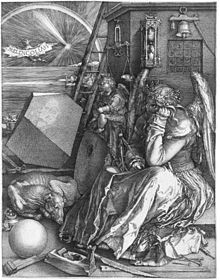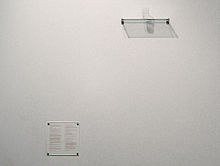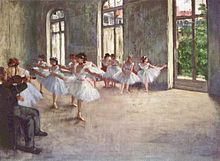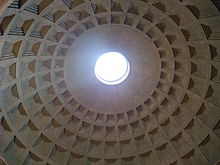
Fine art
About this schools Wikipedia selection
This Wikipedia selection is available offline from SOS Children for distribution in the developing world. SOS Children works in 45 African countries; can you help a child in Africa?
 |
||||||||||||||||||||||||||
| Art history series |
||||||||||||||||||||||||||
|
||||||||||||||||||||||||||

Fine art, from the 17th century on, is art forms developed primarily for aesthetics and/or concept, distinguishing them from applied arts that also have to serve some practical function.
Historically, the five greater fine arts were painting, sculpture, architecture, music and poetry, with minor arts including drama and dancing. Today, the fine arts commonly include the visual art and performing art forms, such as painting, sculpture, collage, decollage, assemblage, installation, calligraphy, music, dance, theatre, architecture, film, photography, conceptual art, and printmaking. However, in some institutes of learning or in museums, fine art and frequently the term fine arts (pl.) as well, are associated exclusively with visual art forms.
Background
One definition of fine art is "a visual art considered to have been created primarily for aesthetic and intellectual purposes and judged for its beauty and meaningfulness, specifically, painting, sculpture, drawing, watercolor, graphics, and architecture."
The word "fine" does not so much denote the quality of the artwork in question, but the purity of the discipline. This definition tends to exclude visual art forms that could be considered craftwork or applied art, such as textiles. The visual arts has been described as a more inclusive and descriptive phrase for current art practice. Also, today there is an escalation of media in which high art is more recognized to occur.
The term is still often used outside of the arts to denote when someone has perfected an activity to a very high level of skill. For example, one might metaphorically say that " Pelé took football to the level of a fine art."
In that sense, there are conceptual differences between the Fine Arts and the Applied Arts. That distinction is largely the result of an issue raised in Britain by the conflict between the followers of the Arts and Crafts Movement, including William Morris, and the early modernists, including Virginia Woolf and the Bloomsbury Group. The former sought to bring socialist principles to bear on the arts by including the more commonplace crafts of the masses within the realm of the arts, while the modernists sought to keep artistic endeavor as exclusive and esoteric.
History
According to some writers the concept of a distinct category of fine art is an invention of the Early Modern period in the West. Larry Shiners in his The Invention of Art: A Cultural History (2003) locates the invention in the 18th century: "There was a traditional “system of the arts” in the West before the eighteenth century. (Other traditional cultures still have a similar system.) In that system, an artist or artisan was a skilled maker or practitioner, a work of art was the useful product of skilled work, and the appreciation of the arts was integrally connected with their role in the rest of life. “Art,” in other words, meant approximately the same thing as the Greek word techne, or in English “skill”, a sense that has survived in phrases like “the art of war,” “the art of love,” and “the art of medicine.” Similar ideas have been expressed by Paul Oskar Kristeller, Pierre Bourdieu, and Terry Eagleton (e.g. The Ideology of the Aesthetic), though the point of invention is often placed earlier, in the Italian Renaissance.
Two-dimensional work
Illustration
An illustration is a visualization such as a drawing, painting, photograph or other work of art that stresses subject more than form. The aim of an illustration is to elucidate or decorate textual information (such as a story, poem or newspaper article) by providing a visual representation.
Painting and drawing
Drawing is a form of visual expression and is one of the major forms within the visual arts. Common instruments include graphite pencils, pen and ink, inked brushes, wax colour pencils, crayons, charcoals, chalk, pastels, markers, stylus, or various metals like silverpoint. There are a number of subcategories of drawing, including cartooning. Certain drawing methods or approaches, such as "doodling" and other informal kinds of drawing such as drawing in the fog a shower leaves on a bathroom mirror, or the surrealist method of " entopic graphomania", in which dots are made at the sites of impurities in a blank sheet of paper, and lines are then made between the dots, may or may not be considered to be part of "drawing" as a "fine art."
Comics
Comics are a graphic medium in which images are utilised in order to convey a sequential narrative. Comics are typically seen as a low art, although there are a few exceptions, such as Krazy Kat and Barnaby. In the late 20th and early 21st century there has been a movement to rehabilitate the medium.
Mosaics
Mosaics are images formed with small pieces of stone or glass, called tesserae. They can be decorative or functional. An artist who designs and makes mosaics is called a mosaic artist or a mosaicist.
Printmaking and imaging

Printmaking is the process of making artworks by printing, normally on paper. Except in the case of monotyping, the process is capable of producing multiples of the same piece, which is called a print. Each print is considered an original, as opposed to a copy. The reasoning behind this is that the print is not a reproduction of another work of art in a different medium — for instance a painting — but rather an image designed from inception as a print. An individual print is also referred to as an impression. Prints are created from a single original surface, known technically as a matrix. Common types of matrices include: plates of metal, usually copper or zinc for engraving or etching; stone, used for lithography; blocks of wood for woodcuts, linoleum for linocuts and fabric in the case of screen-printing. But there are many other kinds, discussed below. Multiple nearly identical prints can be called an edition. In modern times each print is often signed and numbered forming a "limited edition." Prints may also be published in book form, as artist's books. A single print could be the product of one or multiple techniques.
Fibre art
Fibre art is a style of fine art which uses textiles such as fabric, yarn, and natural and synthetic fibers. It focuses on the materials and on the manual labour involved as part of its significance.
Calligraphy

Calligraphy is a type of visual art. It is often called the art of fancy lettering (Mediavilla 1996: 17). A contemporary definition of calligraphic practice is "the art of giving form to signs in an expressive, harmonious and skillful manner" (Mediavilla 1996: 18). Modern calligraphy ranges from functional hand-lettered inscriptions and designs to fine-art pieces where the abstract expression of the handwritten mark may or may not compromise the legibility of the letters (Mediavilla 1996). Classical calligraphy differs from typography and non-classical hand-lettering, though a calligrapher may create all of these; characters are historically disciplined yet fluid and spontaneous, improvised at the moment of writing (Pott 2006 and 2005; Zapf 2007 and 2006).
Photography
Fine art photography refers to photographs that are created to fulfill the creative vision of the artist. Fine art photography stands in contrast to photojournalism and commercial photography. Photojournalism visually communicates stories and ideas, mainly in print and digital media. Fine art photography is created primarily as an expression of the artist’s vision, but has also been important in advancing certain causes. The work of Ansel Adams in Yosemite and Yellowstone provides an example. Adams is one of the most widely recognized fine art photographers of the 20th century, and was an avid promoter of conservation. While his primary focus was on photography as art, his work raised public awareness of the beauty of the Sierra Nevada and helped to build political support for their protection.
Sculpture

Sculpture is three-dimensional artwork created by shaping hard or plastic material, commonly stone (either rock or marble), metal, or wood. Some sculptures are created directly by carving; others are assembled, built up and fired, welded, molded, or cast. Because sculpture involves the use of materials that can be moulded or modulated, it is considered one of the plastic arts. The majority of public art is sculpture. Many sculptures together in a garden setting may be referred to as a sculpture garden.
Conceptual art
Conceptual art is art in which the concept(s) or idea(s) involved in the work take precedence over traditional aesthetic and material concerns. The inception of the term in the 1960s referred to a strict and focused practice of idea-based art that often defied traditional visual criteria associated with the visual arts in its presentation as text. However, through its association with the Young British Artists and the Turner Prize during the 1990s, its popular usage, particularly in the UK, developed as a synonym for all contemporary art that does not practice the traditional skills of painting and sculpture.
Dance
Dance is an art form that generally refers to movement of the body, usually rhythmic, and to music, used as a form of expression, social interaction or presented in a spiritual or performance setting. Dance is also used to describe methods of non-verbal communication (see body language) between humans or animals ( bee dance, patterns of behaviour such as a mating dance), motion in inanimate objects (the leaves danced in the wind), and certain musical genres. In sports, gymnastics, figure skating and synchronized swimming are dance disciplines while the katas of the martial arts are often compared to dances.
Theatre
Modern Western theatre is dominated by realism, including drama and comedy. Another popular Western form is musical theatre. Classical forms of theatre, including Greek and Roman drama, classic English drama (Shakespeare and Marlowe comprised), and French theatre ( Molière included), is still performed today. In addition, performances of classic Eastern forms such as Noh and Kabuki can be found in the West, although with less frequency.
Film
Fine arts film is a term that encompasses motion pictures and the field of film as a fine art form. A fine arts movie theatre is a venue, usually a building, for viewing such movies. Films are produced by recording images from the world with cameras, or by creating images using animation techniques or special effects. Films are cultural artifacts created by specific cultures, which reflect those cultures, and, in turn, affect them. Film is considered to be an important art form, a source of popular entertainment and a powerful method for educating — or indoctrinating — citizens. The visual elements of cinema give motion pictures a universal power of communication. Some films have become popular worldwide attractions by using dubbing or subtitles that translate the dialogue.
Cinematography is the discipline of making lighting and camera choices when recording photographic images for the cinema. It is closely related to the art of still photography, though many additional issues arise when both the camera and elements of the scene may be in motion.
Independent filmmaking often takes place outside of Hollywood, or other major studio systems. An independent film (or indie film) is a film initially produced without financing or distribution from a major movie studio. Creative, business, and technological reasons have all contributed to the growth of the indie film scene in the late 20th and early 21st century.
Architecture
Architecture is frequently considered a fine art, especially if its aesthetic components are spotlighted — in contrast to structural-engineering or construction-management components. Architectural works are perceived as cultural and political symbols and works of art. Historical civilizations often are known primarily through their architectural achievements. Such buildings as the pyramids of Egypt and the Roman Colosseum are cultural symbols, and are important links in public consciousness, even when scholars have discovered much about past civilizations through other means. Cities, regions and cultures continue to identify themselves with, and are known by, their architectural monuments.
Games
There is a debate in the games industry, academia and video game culture regarding the stature of games as a fine art. Film critic Roger Ebert once has argued that games can never be art, as he claimed they lack the authorial control seen in film, and leave too much up to choice. However, he later stated that he was too unfamiliar with video games to judge them, although he still wasn't convinced at the time that video games are art. Nevertheless, as of 2012, he was open to the possibility that video games are art.
Other
- Avant-garde music is frequently considered both a performing art and a fine art.
- Creative writing —distinct from journalism or technical writing, as well as different from most forms of academic writing and organizational communications— is, as previously mentioned, frequently considered a fine art.
- Electronic Media —perhaps the newest medium for fine art, since it utilizes modern technologies such as computers from production to presentation. Includes, amongst others, video, digital photography, digital printmaking and interactive pieces.
- Textiles, including quilt art and "wearable" or "pre-wearable" creations, frequently reach the category of fine art objects, sometimes like part of an art display.
- Western art (or Classical) music is a performing art frequently considered to be fine art.
Academic study
In the United States an academic course of study in fine art may include the Bachelor of Arts in Fine Art, or a Bachelor of Fine Arts, and/or a Master of Fine Arts degree — traditionally the terminal degree in the field. Doctor of Fine Arts degrees —earned, as opposed to honorary degrees— have begun to emerge at some US academic institutions, however.









